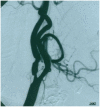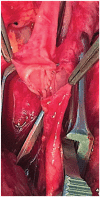Eversion endarterectomy under full prasugrel treatment
- PMID: 29163956
- PMCID: PMC5692133
- DOI: 10.1177/2050313X17741826
Eversion endarterectomy under full prasugrel treatment
Abstract
The third-generation thienopyridine prasugrel has much stronger antiplatelet effect compared to other current antiplatelet inhibitors and exhibits practically zero resistance in healthy people. Prasugrel is used as a pre- and post-treatment in percutaneous coronary or neurovascular interventions with parallel aspirin regime. However, as there is a higher reported bleeding with intraluminal interventions and meticulous technique is recommended, there is nearly non-existent international experience of open surgery under full prasugrel treatment. We present, herein, a case of open carotid endarterectomy with the eversion technique in an asymptomatic patient with carotid stenosis, who was receiving dual antiplatelet therapy with aspirin and prasugrel, due to a previous insertion of two newer drug-eluting stents at the left anterior descending artery and the right coronary artery. The resistance test to prasugrel showed complete inhibition of platelet function. Open surgery was performed under continuation of prasugrel treatment and interruption of aspirin for 3 days before surgery. No perioperative and postoperative neurologic or cardiologic event occurred. No bleeding at the cervical or cerebral area was noted.
Keywords: Prasugrel; coronary stenting; eversion carotid endarterectomy.
Conflict of interest statement
Declaration of conflicting interests: The author(s) declared no potential conflicts of interest with respect to the research, authorship, and/or publication of this article.
Figures






Similar articles
-
The potential role of prasugrel in secondary prevention of ischemic events in patients with acute coronary syndromes.Postgrad Med. 2009 Jan;121(1):59-72. doi: 10.3810/pgm.2009.01.1955. Postgrad Med. 2009. PMID: 19179814 Review.
-
Dual Antiplatelet Therapy Does Not Increase the Risk of Bleeding After Carotid Endarterectomy: Results of a Prospective Study.Ann Vasc Surg. 2017 Apr;40:39-43. doi: 10.1016/j.avsg.2016.09.012. Epub 2017 Feb 2. Ann Vasc Surg. 2017. PMID: 28161565
-
Rationale and design of the dual antiplatelet therapy study, a prospective, multicenter, randomized, double-blind trial to assess the effectiveness and safety of 12 versus 30 months of dual antiplatelet therapy in subjects undergoing percutaneous coronary intervention with either drug-eluting stent or bare metal stent placement for the treatment of coronary artery lesions.Am Heart J. 2010 Dec;160(6):1035-41, 1041.e1. doi: 10.1016/j.ahj.2010.07.038. Am Heart J. 2010. PMID: 21146655 Clinical Trial.
-
Rebound platelet activation after termination of prasugrel and aspirin therapy due to confirmed non-compliance in patient enrolled in the JUMBO Trial.Int J Clin Pract. 2006 Jul;60(7):863-6. doi: 10.1111/j.1742-1241.2006.00999.x. Int J Clin Pract. 2006. PMID: 16846403
-
Organ transplantation and drug eluting stents: Perioperative challenges.World J Transplant. 2016 Dec 24;6(4):620-631. doi: 10.5500/wjt.v6.i4.620. World J Transplant. 2016. PMID: 28058211 Free PMC article. Review.
References
-
- Darius H. Prasugrel. Hamostaseologie 2012; 32: 186–190. - PubMed
-
- Hashimoto M, Sugidachi A, Isobe T, et al. The influence of P2Y12 receptor deficiency on the platelet inhibitory activities of prasugrel in a mouse model: evidence for specific inhibition of P2Y12 receptors by prasugrel. Biochemical Pharmacol 2007; 74: 1003–1009. - PubMed
-
- Janssen PW, Ten Berg JM. Platelet function testing and tailored antiplatelet therapy. J Cardiovasc Transl Res 2013; 6: 316–328. - PubMed
-
- Jakubowski JA, Winters KJ, Naganuma H, et al. Prasugrel: a novel thienopyridine antiplatelet agent. A review of preclinical and clinical studies and the mechanistic basis for its distinct antiplatelet profile. Cardiovasc Drug Rev 2007; 25: 357–374. - PubMed
Publication types
LinkOut - more resources
Full Text Sources
Other Literature Sources

